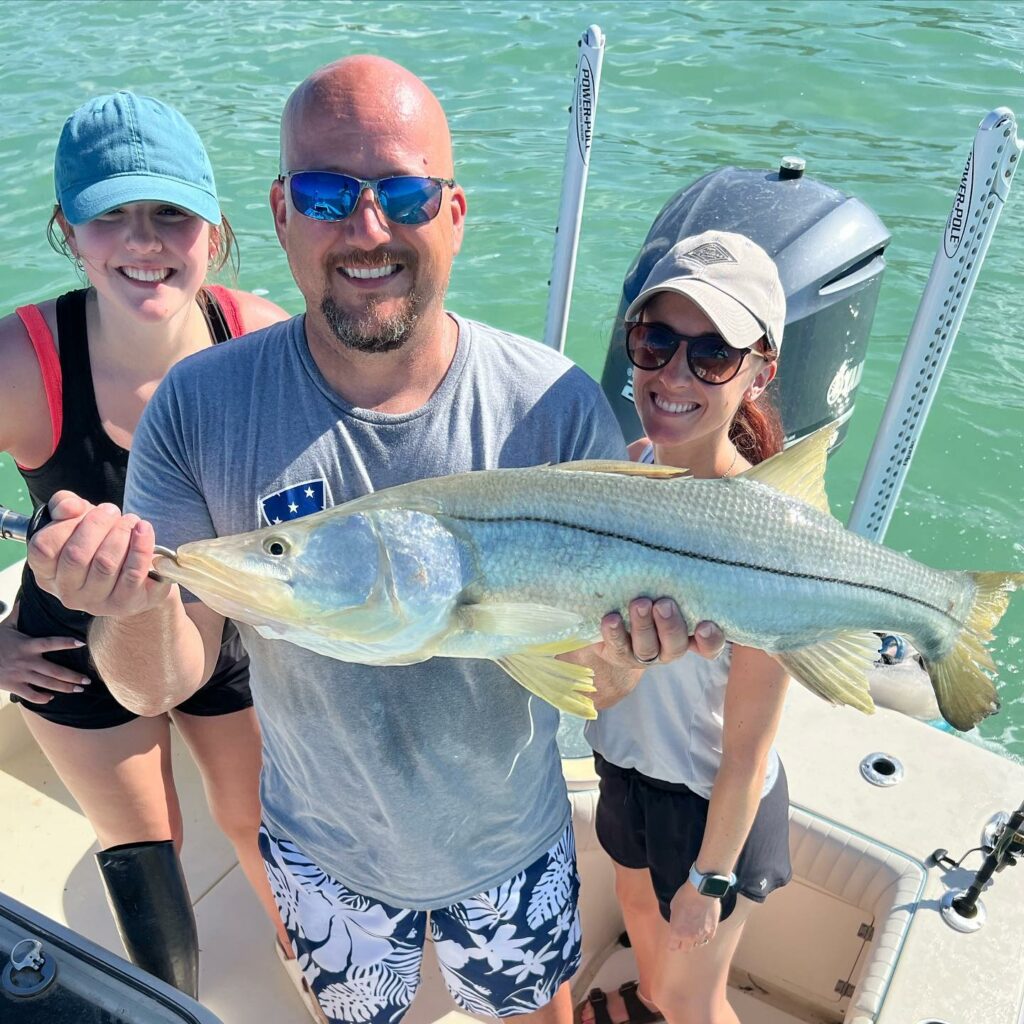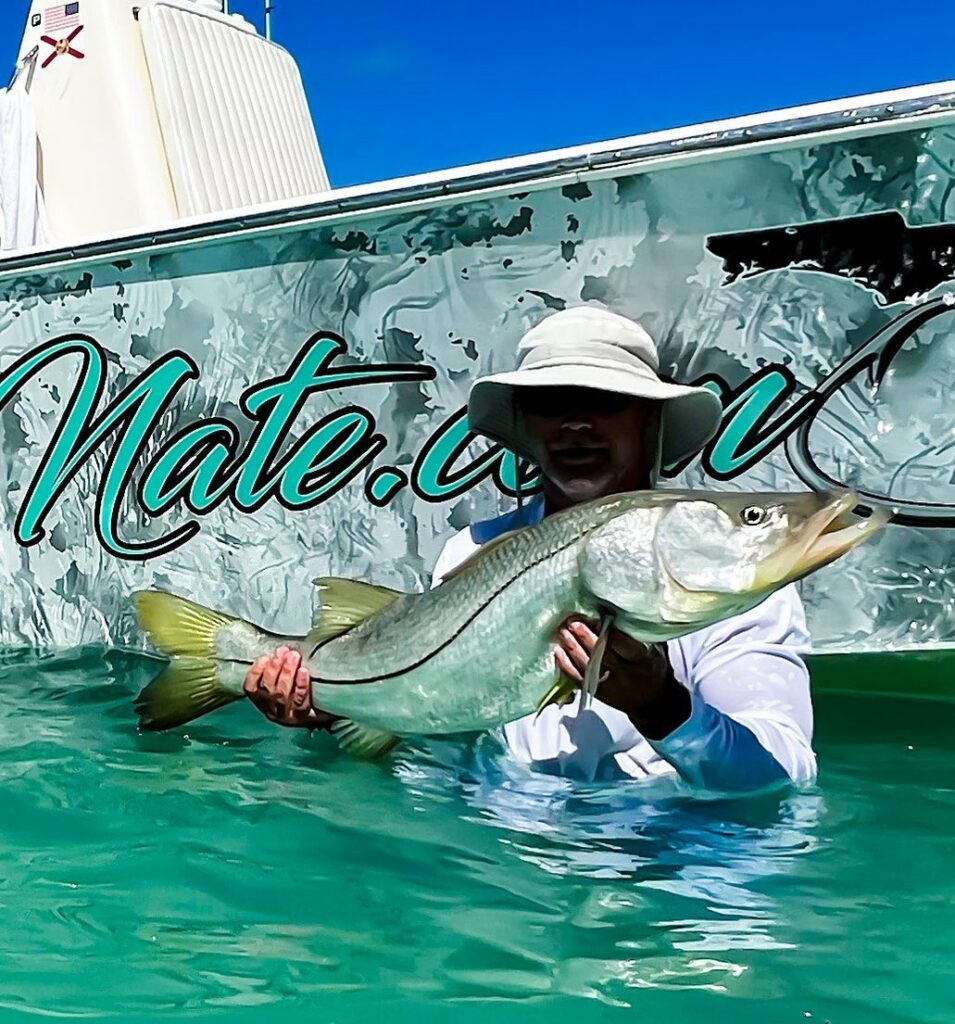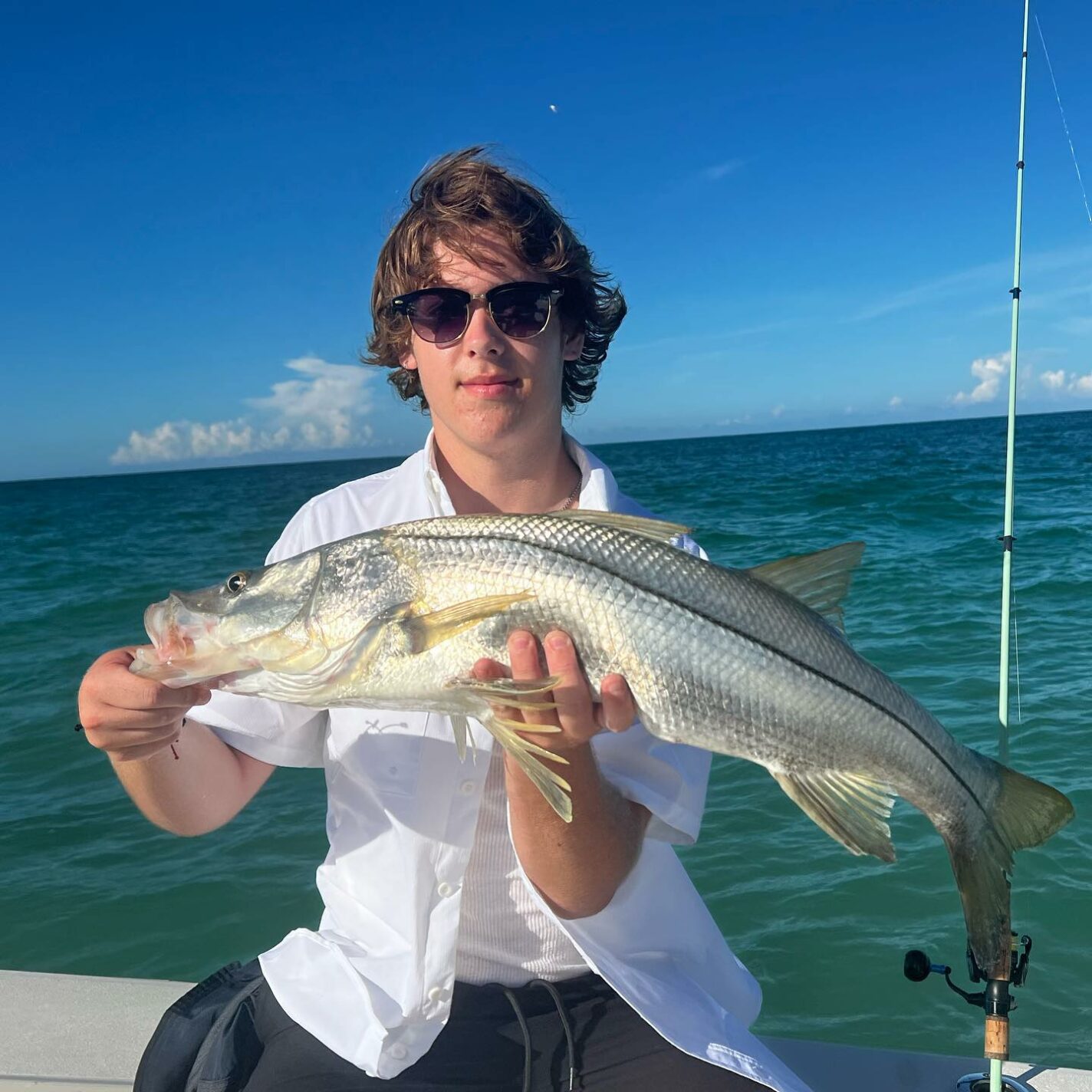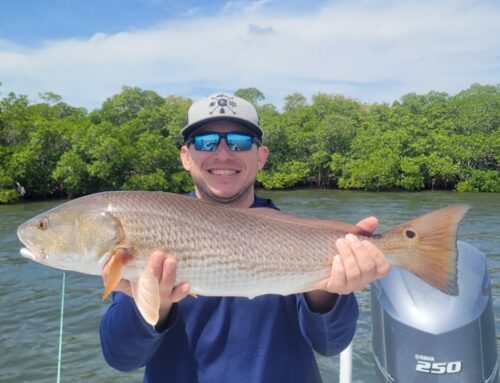Last Updated on April 2, 2025 by Writer
Snook are a defining species in the nearshore and inshore waters around Anna Maria Island. Known for their powerful runs, acrobatic strikes, and ability to disappear into tight cover, they are one of the most sought-after gamefish on Florida’s Gulf Coast. From mangrove shorelines to passes, beaches, and bridge structure, the areas around Anna Maria provide everything these fish need to feed, spawn, and stage throughout the year.
This guide outlines everything fishermen need to know about snook fishing—from seasonal behavior and habitat to gear selection, bait options, and techniques that consistently produce results in this part of Florida.
Detailed Species Description: Snook
Common snook (Centropomus undecimalis) are a warmwater coastal species recognized by their sleek, streamlined bodies, prominent black lateral line, and sloped head. Their coloration can vary depending on water clarity and environment, but they’re typically silver to golden on the sides, with a greenish back and a white belly. Snook are ambush predators, relying on speed, vision, and precision to strike baitfish and crustaceans with sudden force.
Unlike some inshore species, snook are highly sensitive to temperature changes. They thrive in water temperatures between 70°F and 85°F and are vulnerable to cold snaps, which influences where they hold throughout the year. Their ability to transition between fresh and saltwater makes them versatile, but they are always drawn to structure and current—whether that’s a jetty, seawall, pass, mangrove root system, or nearshore reef.

Seasonal Movement and Behavior
Snook fishing off Anna Maria Island is most consistent from late spring through early fall, though fish can be caught year-round in the right conditions. Understanding how snook move and feed through the seasons is key to staying on fish.
Spring
As water temperatures rise, snook move out of deeper winter staging areas and begin to spread across the flats, mangroves, and tidal creeks. Feeding activity increases, especially during warming trends paired with stable barometric pressure. Spring is a prime time to find snook staging in predictable current lanes and pushing bait along shorelines, especially on incoming tides.
Summer
Summer brings spawning season. Snook stage around passes, bridges, beaches, and nearshore structure where current and salinity conditions support spawning. During this period, they feed aggressively and are often found in larger groups. Fishing early mornings, evenings, or during peak tidal flow tends to be most productive, especially when water temperatures begin climbing into the high 80s.
Fall
After spawning, snook begin to shift back toward interior zones. Fall is a transitional period where feeding continues steadily, especially as mullet and other baitfish begin their seasonal migrations. The first signs of cooling water will often concentrate fish along channel edges, points, and high-flow areas as they prepare for winter.
Winter
Cold fronts can push snook into deeper canals, river systems, or thermal refuge areas. Fishing slows but does not stop. On warming afternoons, snook will slide into shallower mud flats or sunny structure to feed. Success during this time requires patience, light tackle, and a focus on timing, especially around midday temperature increases.
Productive Locations off Anna Maria Island
The waters surrounding Anna Maria Island provide a variety of structure and water types that support snook year-round. Each zone offers a different opportunity depending on season, tide, and weather.
Mangrove Shorelines
The island’s eastern and southern shorelines are lined with mangrove systems that hold snook during spring and fall. Overhanging branches, submerged roots, and shade lines all create ambush cover. These areas are best fished on a rising or high tide when snook move closer to the bank.
Beaches and Open Shorelines
In summer, snook move onto open beaches and sandy points, especially during early mornings and calm days. Sight fishing along the trough just off the sand can produce consistent strikes. These fish are typically more active and less pressured, making them excellent targets for accurate casts and lighter tackle.
Passes and Channels
Bean Point, Longboat Pass, and nearby channels provide strong current and bait concentration. These are high-traffic areas for both fish and boats, so timing and positioning are critical. Drifted live bait or casting soft plastics during tide movement can be very effective in these deeper, more dynamic areas.
Bridges and Docks
Bridge pilings and dock structure attract snook throughout the year, especially during summer. At night, lights over the water create perfect ambush conditions, and snook will sit just outside the glow, waiting for bait to pass through. These areas require precise casting and control to keep fish from breaking off.
Grass Flats and Edges
While snook are not strictly flat-dwelling fish, they use the edges of seagrass beds for ambush points during early morning or moving tide conditions. Mixed grass and sand flats near drop-offs or channels often produce consistent results when fished with topwater or slow-moving subsurface lures.

Gear and Tackle Setup
Snook fishing off Anna Maria Island calls for a balance of strength, precision, and flexibility. Tackle should match the size of the fish and the type of structure being fished.
Rods and Reels
-
Rods: Medium-heavy spinning rods from 7 to 7½ feet offer a good combination of casting distance and control. A fast-action tip helps with lure accuracy while retaining power for hard hooksets.
-
Reels: 3000 to 4000 series spinning reels with smooth drag systems are suitable for most snook scenarios. When fishing close to structure or heavier current, stepping up to a 5000 series may be appropriate.
Line and Leader
-
Main Line: 20 to 30 lb braid provides the responsiveness and strength needed to stop a fish before it reaches cover.
-
Leader: 30 to 40 lb fluorocarbon leader is the standard. In clear water, reduce to 20 lb for finesse presentations. When targeting large snook around heavy structure, increasing to 50 lb may be necessary.
Best Baits and Lures for Snook
Snook respond well to both live bait and artificial lures, with bait selection often depending on time of year, water clarity, and fishing pressure.
Live Baits
-
Pilchards (Whitebait): A go-to bait for much of the year. Chummed or cast, they work well across all structure types.
-
Pinfish: Hardy and aggressive, excellent for fishing deeper channels or bridge structure.
-
Mullet: Particularly effective in the fall when larger fish are feeding heavily ahead of winter.
-
Shrimp: Useful in winter or when fish are less active. Best presented on light tackle and drifted naturally.
Artificial Lures
-
Topwater Plugs: Walking baits and chuggers are highly effective during low light hours, especially on the beach or open flats.
-
Soft Plastic Jerkbaits: Rigged weightless or on light jigheads, these allow subtle presentations in shallow water or tight cover.
-
Swimbaits: Paddle tails rigged on ⅛ to ⅜ oz jigheads are effective in current and along edges. Natural colors often produce the best results.
-
Suspending Twitchbaits: Ideal for fishing docks, bridges, or shadow lines where a slower retrieve keeps the lure in the strike zone.
Snook are smart and adaptable. Repeating a presentation too often in one area can lead to refusals. Adjusting angle, speed, or bait size can make the difference when fish become selective.
Techniques for Targeting Snook
Casting to Structure
Most snook are caught within a few feet of structure. Accurate casting and quiet positioning are critical. Letting the bait or lure settle and naturally drift toward the fish often draws the best response.
Drifting Live Bait
In channels or passes, drifting pilchards or pinfish along the current line allows for natural movement and maximizes the chance of a reaction strike.
Night Fishing
Bridge lights and dock lights create feeding zones after dark. Casting soft plastics or live shrimp just outside the light pool and slowly working them through the transition zone is a proven technique.
Sight Fishing the Beach
In summer, walking the beach and spotting snook in the first trough can offer close-range, visual fishing. These fish can be spooky, so accurate casting and quiet footwork are important.
Chumming with Whitebait
Chumming with live pilchards can bring fish out of cover and trigger competition. This is especially useful when fishing mangroves or shoreline points in spring and summer.

Handling and Legal Limits
Snook are managed carefully in Florida and subject to seasonal harvest closures and slot limits. Many fish are released, and proper handling ensures they remain healthy and unharmed.
-
Always wet hands before touching the fish.
-
Support the body horizontally—never hold snook vertically by the jaw.
-
Remove hooks gently using pliers or a dehooking tool.
-
Limit time out of the water if releasing.
-
If keeping a legal fish, place it on ice immediately.
Current regulations for snook in the Gulf region are:
-
Slot size: 28″ to 33″ total length
-
Bag limit: 1 per person per day
-
Harvest season: March 1 to April 30 and September 1 to November 30 (subject to change)
-
A snook permit is required in addition to a Florida saltwater fishing license
Always verify up-to-date regulations before harvesting.
Planning Your Snook Trip with Captain Nate
Fishing for snook off Anna Maria Island offers some of the most hands-on, responsive, and rewarding fishing Florida’s Gulf Coast has to offer. With fish that hit hard, fight clean, and hold in structure-rich water year-round, it’s a fishery built around movement, awareness, and timing.
Captain Nate has spent years learning how snook behave in this region, from early spring patterns along the mangroves to late summer beach runs and fall transitions. Whether you’re targeting your first snook or looking to fine-tune your approach, every trip is shaped around current conditions, tide movement, and seasonal behavior.
Book a trip today to reserve your spot and fish the waters around Anna Maria Island with a guide who’s dedicated to putting you on fish and helping you make the most of every cast.




